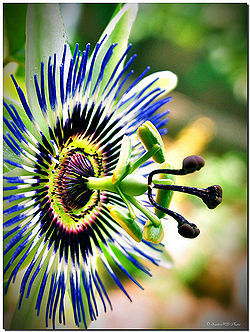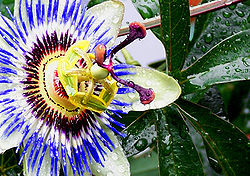Passionflower
| Passionflower |
|---|

|
| Scientific Classification |
|
| Species |
|
| Passion Flower |
The Passionflower is the common name for the extravagant flowers produced by over 500 species in the genus Passiflora. They mainly grow in vines and produce herbs, flowers, and fruit. The herbs and some specific species of the flowers can be used for medical purposes such as relaxants and tranquilizers. The plant produces berry-like fruit, such as the passion fruit or Granadilla. Flowers can be found world wide except for Europe, Antarctica, and Africa. They are mainly found in the South Eastern parts of the U.S. where about nine of the hundreds of species are located. The rest are found in places such as South America, China, Southern Asia, New Guinea, Australia, and New Zealand. Caterpillars, such as the Zebra Longwing, feed on the Passion Flower's leaves because there is a toxin in there that makes the Zebra Longwing poisonous to its predators clear until turns into a butterfly. Then it drinks the nectar to keep itself poisonous. It is usually fertilized by carpenter bees, but can also be pollinated by animals such as hummingbirds. The Passion Flower is also known as maypop. It is a woody vine which reminded early pilgrims of the passion or suffering of Christ.
Anatomy
The male stamen is formed by the anther and filament; pollen arises from the anthers. The pollinator puts the pollen in the female stigma. This germinates and then it sends a tube, which carries the male sex germ, down through the style and then to an ovule inside the ovary. Once this occurs, the ovary will then ripen into a yellow lemon-sized fruit that can be eaten; the ovules in the fruit will soon mature into seeds. Mostly all passion flowers have ten whitish petals. After examining each "petal" closely, it becomes apparent that each petal is a bit more scoop-shaped and green-margined than the next. The sepals are the green-margined ones and the flatter, whiter ones are indeed the petals.
All of the parts that are mentioned in the previous paragraph are placed above the lower section on a unique kind of stalk known as a gynophore. Once the fruit develops, the stalk will still be attached. This method is one way to tell if what you are looking at is a passion flower or just another lemon-shaped, yellow flower.
One of the amazing features in a Passion Flower is the long, skinny items extending out from the bottom of the gynophore. In a few kinds of special flowers a sprout is made on the blossom's lower or middle parts. This is where all the sepals, petals, and sexual parts become connected. The outcome of this is usually known as a corona, or "crown." Passion Flower crowns become apparent in a similar way; although, instead of being cup-like, they are all divided into many hair-like items. The highly divided crowns help with the pollination because they attract the pollinator’s attention to the middle of the flower, where pollination needs to be taken or dispersed. [1]
Reproduction
Other than to keep the Passion Flowers from going extinct, there is one more reason for there to be pollination. It is to keep the Passion Fruit growing. The structure of the flower and the heavy, sticky pollen that goes with it makes wind pollination an impossible task. Their alternative reliance is the use of other creatures, which involves insects or even hummingbirds, to pollinate themselves. Bees tend to do the best job at their task; pollinating the flowers. Flies can also pollinate in the sense that they will eat some of the pollen from one Passion Flower, then fly to another and accidentally transfer a little bit of it. In the Passion Flowers that grow in the U.S., the preferred pollinator is the carpenter bee. The specific bee burrows its way into wood and makes his home. Some gardeners put wood around where they are growing their flowers so that hopefully the crop will be plentiful. [2]
Basically, every Passion Flower has a male part and a female part; the male anthers, which produce pollen, and the female stigmas, which receive it. Pollen travels by sending a tube down from the stigma through the style to the ovary. Sperm that is contained within the pollen fertilizes eggs on the way down to the tube, which is in the ovary. The tube is then demolished. If the whole process works how it is designed, Passion Flowers and Passion Fruit will always be abundant and will never run out. [3]
Ecology
The Zebra Longwing feeds on the Passion Flower. It is used for purposes such as the nectar toxins. The Zebra Longwing also lays all her eggs on Passion Flowers, preferably the Yellow Passion Flower, because the toxins in the flower absorb into the larvae and make the Zebra Longwing poisonous to all its predators.[4] As caterpillars, they feed on the leaves of the Passion Flower also to put the toxins in their body making them poisonous. [5]
The Passion Flower is a plant that is found in almost any part of the world. It, however, does not live in Europe, Antarctica, or Africa. In Kansas and Pennsylvania, the Passion Flower is withering away; although, both are at the edge of where they range to in the United States. It is quite possible that the Passion Flower is sparse in these states because they are right on the edge of the species’ economical tolerance. The Passion Flower's wetland habitat is a target for human disturbance because they target wetlands for drainage, which can ruin the living needs of the Passion Flower. If there were more healthy wetlands in Kansas and Pennsylvania, there would be a better chance for the Passion Flowers to survive there, even though they are at the edge of their economical capability. [6]
Edible & Medical
The Passion Flower can be used for eating and medical related purposes. The succulent fruit and flowers can be eaten without being cooked, or cooked in sweets such as jellies or jams. The young leaves can be cooked and used as seasonings or put into salads. It has scientifically been proven that the medicine can be formed from this plant's herbs. Recently, studies have shown that the flavonoids in the Passion Flower are the main reason that this flower causes a relaxing and anti-anxiety effect. Some of the Passion Flowers put together Apigenin, Kaempferol, Quercetin, and Luteolin. These medicines are being examined and showing promising chances in being able to fight Cancer, Parkinson's Disease, Leukemia, HIV, and a few more. The stems and leaves are used as antispasmodic, astringent, diaphoretic, hypnotic, narcotic, sedative, vasodilator and are also used to calm and quiet the complaints of women. The Passion Flower also is a substitute for insomnia, neuralgia, irritable bowel syndrome, nervous tension, irritability, premenstrual tension and vaginal discharges. [7]
Gallery
Passion Flower
(Passiflora alata)
Passion Flower
(Passiflora foetida)
References
- Passion Flowers Sep 05 2006
- Passionflower - uses and medical properties Deb Jackson & Karen Bergeron
- Why They're Rare August 2007
- Zebra Longwing Butterfly Nature Works
- The Zebra Longwing Marianne Cowley. 1997-2005
- Passion Flower Fertilization
- Passion flower Jennifer Schultz Nelson. August 8, 2007






